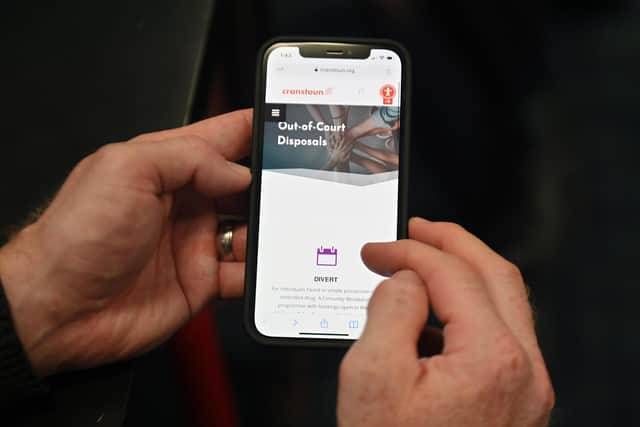Insight: Why drugs is a health issue first, a criminal one second
The 33-year-old has been brought in on suspicion of robbery, and is waiting to be told if he will be taken to court. In the meantime, he has been talking to Lisa Raven, an arrest referral worker from the third sector organisation Cranstoun, about more support for his long-standing addiction.
“I have been in drug treatment but I need more help understanding how to wean myself off my scripts without topping up with other substances,” says Jack, who tested positive for heroin on admission. “It’s good to speak to Lisa - because she understands addiction and speaks to me on my own level. I don’t feel I am being interrogated.”
Advertisement
Hide AdAdvertisement
Hide AdMinutes later, a police officer arrives at the cell door to say Jack is being released without charge. He intends to head straight to the chemist. Thanks to a newly-launched West Midlands scheme - the first of its kind in the UK - he will be given clean needles and Naloxone, the antidote to an opioid overdose as he leaves.


“Here you’ve got a guy who is not going to court, he is going to be released back into the community, but if he hadn’t come into custody, he wouldn’t have met Lisa,” says Arron Owen, Cranstoun’s national lead for criminal justice. “The criminal justice system can be an effective way of engaging with people. He shouldn’t be here, but he’s had an intervention at the same time.”
The Oldbury building, which opened in 2016, is one of two large custody suites - a sort of halfway house between a police station and a prison - operated by West Midlands Police.
As the doors open, it’s like stepping onto the set of Star Trek. At its heart, stands a large semi-circular control centre with five reception windows. Radiating out from each window is a long, rectangular wing. There are 12 cells per wing, 60 in total. The cells have a toilet and washbasin, anti-graffiti surfaces and reflective ceiling domes so occupants can be seen at all times. Four are designed for disabled detainees and six have windows for those considered at risk of self-harm.
I have been invited to the custody suite by Owen, who is showing me the work Cranstoun has been undertaking to reduce drug use and drug-related crime.


For the last few years, I have been following drug policy in Scotland. As everyone knows, the country is in the grips of a drug epidemic. As the SNP “took [its] eye off the ball”, cutting funds to frontline services, the number of drug-related deaths spiralled so we now have the highest drug death rate per capita in western Europe.
Part of the problem lay in policy stasis. The Scottish and UK governments were locked in a constitutional battle, each blaming the other for a lack of action. The SNP said it wanted to treat drugs as a health issue but was stymied by the fact national drugs policy sits with the Home Office. Its critics suggested there was much more it could be doing with its existing powers.
More recently, however, there has been a shift. After the shocking 2019 figures were released last December, First Minister Nicola Sturgeon announced £50m a year over five years for services and appointed a dedicated drugs minister, Angela Constance.
Advertisement
Hide AdAdvertisement
Hide AdAnother catalyst has been the change in Lord Advocate. Dorothy Bain QC seems more willing to look for ways round the limitations imposed by the UK’s outdated Misuse of Drugs Act 1971. Earlier this year, she announced Recorded Police Warnings (RPWs) could now be given for users caught in possession of Class A drugs (previously they were used only for cannabis). And last week, she told the justice committee she hoped to look again at Drug Consumption Rooms, effectively ruled out as illegal by her predecessor.


The Scottish Government is now keen to examine different approaches being implemented by English forces where a handful of forward-looking Police and Crime Commissioners (PCCs) have been driving a more challenging agenda.
I was particularly interested in the West Midlands. There, Cranstoun has been commissioned to provide both DIVERT - a pre-arrest diversion scheme for users caught in possession of drugs - and the arrest referral scheme where those detained in connection with “trigger” offences - offences often committed to fund addiction - can be supported and connected to services.
These schemes are not unique to the West Midlands; but what marks the area out is that they are being implemented force wide across seven local authorities and a population of two million.
“Attitudes are changing,” Owen says. “From 2007-11, I was a drugs officer with the police and there was an initial feeling of: ‘We don’t want you here. This isn’t the environment for you.’ But some of the police officers back then went into senior roles. Now you have chief inspectors and superintendents who realise 50 years of locking people up hasn’t worked.”


*************
Like Scotland, the West Midlands has a high number of problematic drug users. The PCC’s office says there is one death every three days and that substance misuse costs the region £1.4bn a year.
“One of the drivers to address this was the issue with Corporation Street - the main thoroughfare from the railway station to the shopping centre,” Owen says. “There were users just lying on the ground and people with money and influence - businessmen, MPs, senior police officers - were walking past this on their way to work.”
The aim of DIVERT, which began last year and is fully digitised, is to intervene early in an individual’s drug use and keep them out of the criminal justice system.
Advertisement
Hide AdAdvertisement
Hide AdWhen a West Midlands police officer catches someone in possession of a small amount of any drug, they can opt to give that person a “community resolution” and refer them to Cranstoun via an app.
The referral is for an initial telephone assessment. During that assessment they will be asked about their drug use and whether or not they have issues with debt, housing or their mental health. Most of those referred through DIVERT will be low-level users, taking cannabis or cocaine. They will be booked onto a virtual drugs education course. More established users will be offered harm reduction advice and connected to a local treatment centre.
At Cranstoun’s own treatment centre in Sandwell - an area of high heroin and crack cocaine use - Owen and Cranstoun director Megan Jones show me the app and take me through the online course which is customised depending on age and the drug involved.
“There are always two facilitators. One leads and one deals with the system and the infrastructure,” Owen explains. “We have a chat function so participants can post anonymous questions or speak directly to the facilitators. We also have break-out rooms so if someone makes a comment that troubles us we can take them there and ask them: ‘Is there anything we can support you with?’”
The course I watch is aimed at 13 to 18-year-olds. It asks participants questions about their drug use and provides information on potential health impacts. For example, with cannabis it talks about the effects of THC and the link to mental health problems.
It also explains that giving drugs to your friends constitutes supply. “That shocks some people,” Owen says. “They don’t realise that if they go to a dealer and buy enough for their group, they’ve become the dealer.”
The course goes on to point out how a criminal record can impact on employment, foreign travel and the cost of car insurance.
There is no penalty for failing to attend. But more than 80 per cent of those referred do attend, and early research suggests those found in possession during a stop and search are twice as likely to be found in possession again in the future if they haven’t taken part in the course than if they have.
Advertisement
Hide AdAdvertisement
Hide AdNon-attendance has other potential consequences too. “You don’t get a criminal record from a community resolution, but the information is pumped into a system, so officers will know you’ve had one before,” says Owen. “You might be given it again, but then again, you might not and whether or not you attended the course is something that will be taken into account.”
The police officers have embraced the new system. The app has been downloaded 4,000 times onto West Midlands police mobile devices. Cranstoun is receiving around 20 referrals a day.
“Before this, if someone had been caught in possession of drugs, you would be talking about up to 12 hours as they were arrested and processed through custody,” Jones says. “There’s a cost element to that, but also a demand on policing. With DIVERT it takes minutes to refer using the app and they are not moving off the side of the road.” Even a caution requires more paperwork.
Those working in the court system, which is buckling under a Covid backlog, are happy too. “We had a conversation with magistrates a couple of months ago, and they were saying: ‘Thank God, because we see these people coming into us and all we can do is fine them’.”
Later, I catch up with Alison, 24, a trainee midwife, caught with cannabis a few weeks earlier.
“I need a clear DBS [disclosure] check to be a midwife so when I got stopped and searched I was beside myself,” she says. “I was sobbing and bawling, but then the police officer told me about DIVERT and I knew that was a good opportunity.”
She says she found the course very informative. But is she really less likely to offend again? “Yeah, I was terrified,” she says. “I’ve been lucky to learn my lesson without the severe consequences that would have impacted my whole life.”
DIVERT will not be used for the most problematic users or those who have committed other offences along with possession. They will be arrested and taken to one of the custody suites to be processed.
Advertisement
Hide AdAdvertisement
Hide AdIf they have committed a trigger offence like Jack they will undergo a compulsory drug test in the DNA room.
“The purpose of the drug test is not to catch anyone out, it’s just to identify those persons committing offences while under the influence of drugs,” says detention escort officer Lee Burstow. “The theory is, if we can identify them, we can get them on a programme, get them off the drugs and, in so doing, reduce the crime in the area.”
Burstow explains officers can also use “an inspector’s authority” to carry out compulsory tests if they have reason to believe drugs have been used in a non-trigger offence. “Nine times out of ten we will use the inspector’s authority to test in relation to acts of violence,” he says.
The tests only detect Class A drugs, not cannabis. Those who test positive are then compelled by law to attend two assessments. The first will be carried out by Raven or her colleagues, the second at their local treatment centre.
The referral workers will also ask to speak to other detainees on a voluntary basis. “They will often tell us things they wouldn’t disclose to the police,” Raven says. “There was a guy I saw yesterday who had been brought in on suspicion of a domestic violence offence. When I spoke to him he had a substance misuse problem, so I flagged it up to the sergeant, did a voluntary assessment and referred him into treatment.”
If Cranstoun is asked to do a pre-sentencing report for someone who has been through arrest referral, they may push for a Drug Rehabilitation Requirement (similar to Scotland’s Drug Treatment and Testing Order).
“The best way to look at it is, after those in custody go through the arrest referral scheme, criminal justice and drug and alcohol treatment carry on separately,” Owen says. “Then it gets to court and we bring it all back together. We might say: ‘Actually this person has engaged well in treatment, don’t disrupt that, give them a community order.’ Then the treatment becomes enforceable by law.
“It’s all about having the right intervention for the right person at the right point.”
*****************
Advertisement
Hide AdAdvertisement
Hide AdAs a visitor from Scotland, I was also interested in the role PCCs have had on shaping policy since they replaced the now-abolished English police authorities in 2012.
The PCC is an elected role held, in most forces, by members of political parties. Both the current West Midlands PCC Simon Foster and his predecessor David Jamieson were Labour candidates.
At police headquarters, I asked assistant PCC Tom McNeil to tell me more.
“My view is that the PCC’s role particularly in the West Midlands has been a game-changer because it provides a whole different level of visibility and accountability,” he says. “It means there is someone who has responsibility for law enforcement, policing and crime, and that can mean anything from early intervention to meaningful rehabilitation.
“You didn’t have that before because chief constables may feel deeply about those agendas but their core business is policing, and there is also a reticence about walking into what can be seen as a political conversation. On the other hand, it’s 100% legitimate, inherent and expected in the role of the PCC to enter those debates, and that’s exactly what we have done.”
A Labour PCC with a Tory government is a difficult dynamic, not dissimilar to the one between the Scottish and UK governments. Like the SNP, McNeil believes drugs are a public health issue, but he too has to work within the Misuse of Drugs Act, which the Conservatives have no intention of reforming. Also, of course, the remit of the PCC is not to help users, but to tackle offending.
And so Foster and McNeil push public health responses to addiction on criminal justice grounds. The messaging is clear. The purpose of the DIVERT and arrest referral schemes is to reduce crime. It just so happens that supporting drug users as they interact with the criminal justice system is an effective way to do that.
“It has been known for a long time that substance addiction is one of the major causes of crime,” says McNeil. “The Labour PCCs have been able to talk about tackling the causes of crime rather than perpetuating a populist narrative.”
Advertisement
Hide AdAdvertisement
Hide AdThe PCC’s office commissioned DIVERT, which costs £60,000, and the arrest referral scheme which costs £1m, but it also funds other smaller early intervention projects. One which McNeil is particularly passionate about is Pathfinder - an initiative in schools in south Birmingham.
In those schools, a pastoral care worker has been appointed to build relationships with children whose families may be engaged in problematic drug use.
“The thing that’s beautiful about this is they have found a way of engaging families in crisis that will engender trust,” McNeil says. “It is not about going in and threatening to take children away, it’s about identifying problems in a way they weren’t being identified before and helping them through poor mental health, long-term unemployment, threats of homelessness.
“It isn’t inquisitorial, it’s compassionate. They build long-lasting relationships, then through those relationships they bring in relevant support services to really great effect.”
These projects are impressives but there are also downsides to having an elected PCC. What happens if Foster is ousted by a Conservative rival at the next election? Are his schemes scrapped in favour of more populist ones? Is all that time and energy wasted?
More generally, some experts would question the coercive nature of the compulsory drug-testing and Cranstoun assessments. And, of course, DIVERT and the arrest referral scheme depend on the rest of the system being properly resourced. But the West Midlands faces the same underfunding as everywhere else. McNeil says the force has lost £175m and 2,000 officers over the last 10 years, while the various treatment services, funded by cash-strapped local authorities, have experienced a degree of fragmentation.
There is little point in encouraging more users to engage with services if those services cannot cope with the demand. McNeil accepts this but says the high profile of PCCs allows them to lobby for greater funding. “Because there’s a visibility in the role, because it has public attention, it means their voice is heard by central Government,” he says.
*************
So what does all this mean for Scotland? What can the country learn from the West Midlands experience?
Advertisement
Hide AdAdvertisement
Hide AdThe first thing to say is that we are not without our own initiatives. Diversion from prosecution has existed for years, and its use is on the rise. In September, the Lord Advocate revealed the number of diversions offered for single charge possession cases had risen from 57 in 2017-18 to 1,000 in 2020-21. But here diversion is a prosecutorial option, rather than a police-led initiative. It involves a referral to the local authority social work department, with no requirement for drug treatment.
The decision to allow RPWs for Class A drugs marks a shift towards earlier intervention, but while RPWs can allow users to avoid prosecution, they will show up in some Advanced Disclosure checks. In addition, while individual offers may refer those who receive RPWs onto services, there is no established system for them to do so.
Tracey Price, of the Salvation Army Centre for Addiction Services and Research at the University of Stirling, suggests that there are institutional, constitutional and legal barriers to implementing pre-arrest diversion in Scotland.
But there is no obvious reason why elements of Cranstoun’s DIVERT model could not be used to ensure a similar pan-Scotland referral to education or treatment services for everyone receiving an RPW for drug possession.
Police Scotland is also involved in several partnership schemes aimed at supporting those with addictions: the Positive Outcomes Project in Glasgow, the Vow project in Edinburgh and a Peer Navigator project in Inverness.
Yet, there is a piecemeal feel to some of these initiatives and a lack of consistency across the country.
Drugs minister Angela Constance says that while the Scottish government and Police Scotland are pursuing new approaches such as the RPWs for Class A drugs, they are also interested in what is happening elsewhere.
“I met the previous West Midlands PPC and Cranstoun along with other organisations across the UK,” she tells me. “There’s a lot of synergy with what we are wrestling with and what we are trying to achieve in terms of diversion, Naloxone and a more joined-up policy approach.”
Advertisement
Hide AdAdvertisement
Hide AdMartin Powell, head of campaigns and communications at the Transform Drugs Policy Foundation, believes the West Midlands stands out because of its tiered approach. “You have the first level where police stop people and divert them, then the second level where - if you do arrest them - you have a consistent policy and fully-funded offers you can refer them onto,” he says. “And you have your protocols in place to ensure this is the norm; so, implemented north of the border, it would mean it wasn’t something that just happened in Inverness or Glasgow, but was national and consistent. Given the West Midlands has three million people and Scotland has five and half, there doesn’t seem to be any reason you could not do it there.”
Constance agrees. “I think the major focus of my attention now is to look at how we move beyond examples of good practice and scale up,” she says. “Scotland is a small country. It cannot and should not be beyond our wit that we get some consistency across [the nation].”